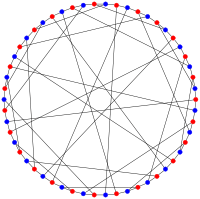Edge-transitive graph
In the mathematical field of graph theory, an edge-transitive graph is a graph G such that, given any two edges e1 and e2 of G, there is an automorphism of G that maps e1 to e2.[1]
In other words, a graph is edge-transitive if its automorphism group acts transitively upon its edges.
Examples and properties

Edge-transitive graphs include any complete bipartite graph , and any symmetric graph, such as the vertices and edges of the cube.[1] Symmetric graphs are also vertex-transitive (if they are connected), but in general edge-transitive graphs need not be vertex-transitive. The Gray graph is an example of a graph which is edge-transitive but not vertex-transitive. All such graphs are bipartite,[1] and hence can be colored with only two colors.
An edge-transitive graph that is also regular, but not vertex-transitive, is called semi-symmetric. The Gray graph again provides an example. Every edge-transitive graph that is not vertex-transitive must be bipartite and either semi-symmetric or biregular.[2]
The vertex connectivity of an edge-transitive graph always equals its minimum degree.[3]
Marston Conder has compiled a Complete list of all connected edge-transitive graphs on up to 47 vertices and a Complete list of all connected edge-transitive bipartite graphs on up to 63 vertices.
See also
- Edge-transitive (in geometry)
References
- Biggs, Norman (1993). Algebraic Graph Theory (2nd ed.). Cambridge: Cambridge University Press. p. 118. ISBN 0-521-45897-8.
- Lauri, Josef; Scapellato, Raffaele (2003), Topics in Graph Automorphisms and Reconstruction, London Mathematical Society Student Texts, Cambridge University Press, pp. 20–21, ISBN 9780521529037.
- Watkins, Mark E. (1970), "Connectivity of transitive graphs", Journal of Combinatorial Theory, 8: 23–29, doi:10.1016/S0021-9800(70)80005-9, MR 0266804